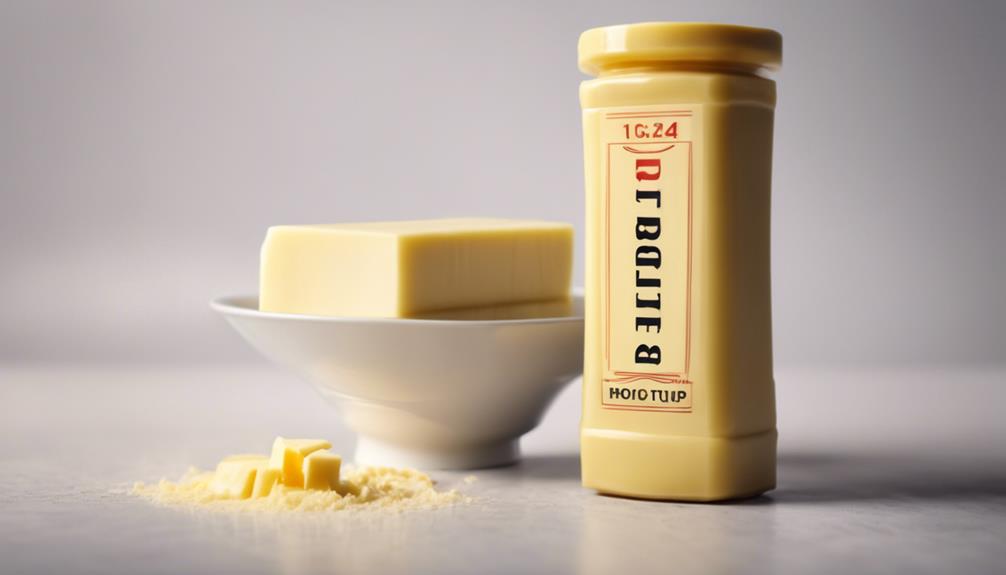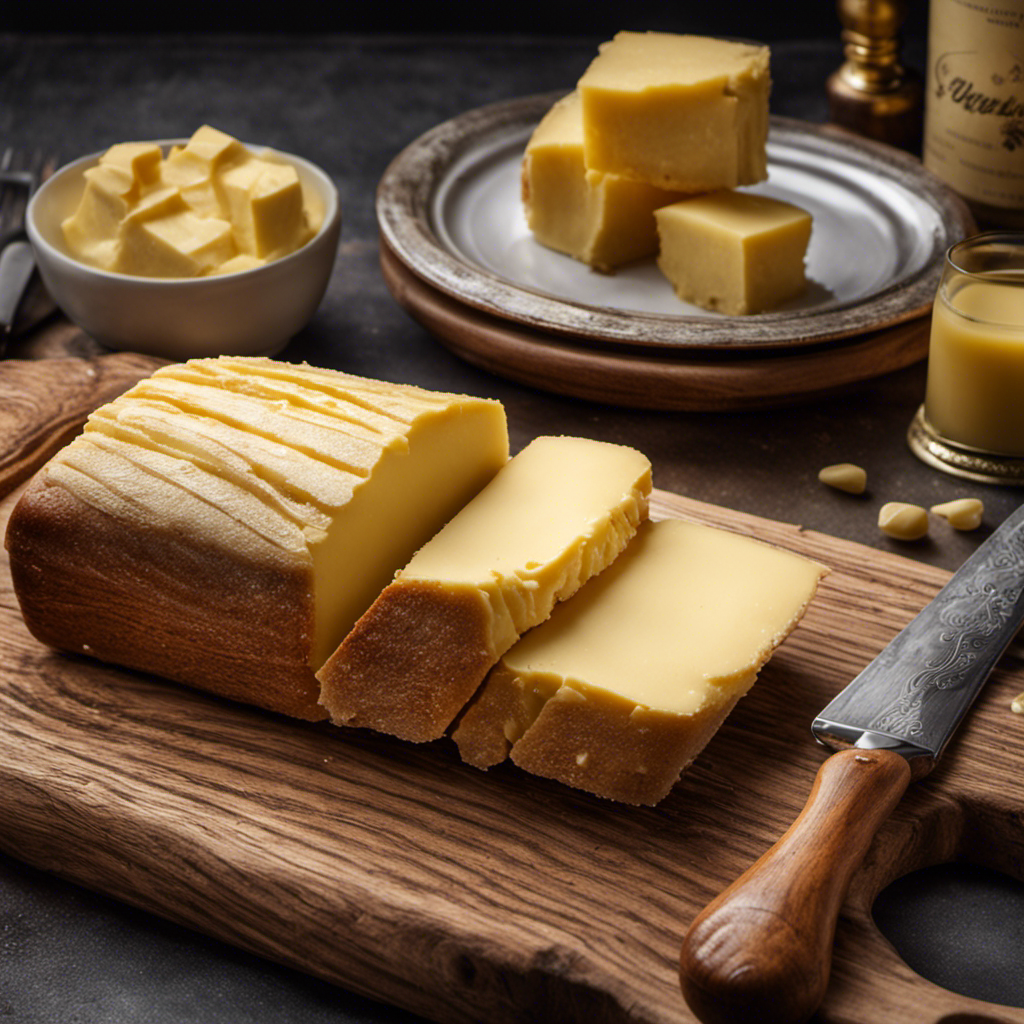Curious about 1/3 cup of butter from a stick? It's 5 tablespoons and 1 teaspoon. This simple conversion helps nail your recipe's butter needs.
Key Takeaways
- A stick of butter is equivalent to 1/2 cup, so 1/3 cup is roughly 5 tablespoons + 1 teaspoon.
- Utilize pre-marked butter wrappers for easy measuring of tablespoons.
- Converting 1/3 cup of butter to tablespoons helps in accurate portioning.
- Remember, 1/3 cup of butter is about 76 grams using the displacement method.
- Understanding butter stick measurements aids in precise recipe preparation.
Importance of Butter Stick Measurements
Understanding the importance of butter stick measurements is vital for precise and efficient recipe preparation. Butter sticks are conveniently marked with measurements for tablespoons, cups, and even fractions like 1/4 cup or 1/3 cup. These markings serve as a guide for accurate measuring, ensuring that the right amount of butter is used in your recipes.
By familiarizing yourself with the measurements on butter sticks, you can easily convert between stick measurements and cups, making your cooking and baking endeavors smoother and more precise.
Measuring cups play a pivotal role when it comes to using butter sticks in recipes. The markings on butter sticks align with standard measuring cup sizes, making it simple to determine the equivalent amount of butter needed. Whether you're following a recipe that calls for a specific number of tablespoons or cups of butter, having a good grasp of butter stick measurements will enable you to confidently measure out the right amount without any guesswork.
Butter Stick Equivalents and Conversions
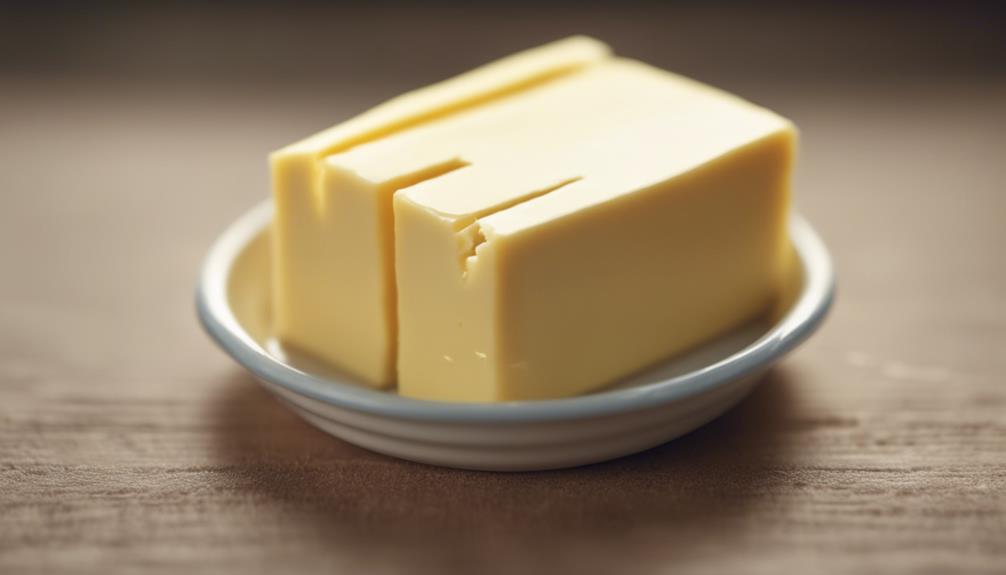
To accurately measure butter in recipes, it's important to be familiar with butter stick equivalents and conversions. Understanding that one third cup of butter equals 5 tablespoons plus 1 teaspoon is crucial to achieving precise measurements in your cooking.
A quarter-pound butter stick contains 8 tablespoons, simplifying the process of measuring 1/3 cup.
Converting between cups and tablespoons aids in portioning butter accurately for various recipes. By knowing that 1/3 cup equals 5 tablespoons plus 1 teaspoon, you can easily adapt your measurements. Pre-marked butter wrappers also come in handy for measuring by tablespoons, making the process more efficient and less prone to errors.
Next time you're preparing a recipe that calls for butter, keep in mind these conversions and equivalents. By mastering butter stick measurements, you can ensure your dishes turn out just right every time.
Measuring Butter for Recipes
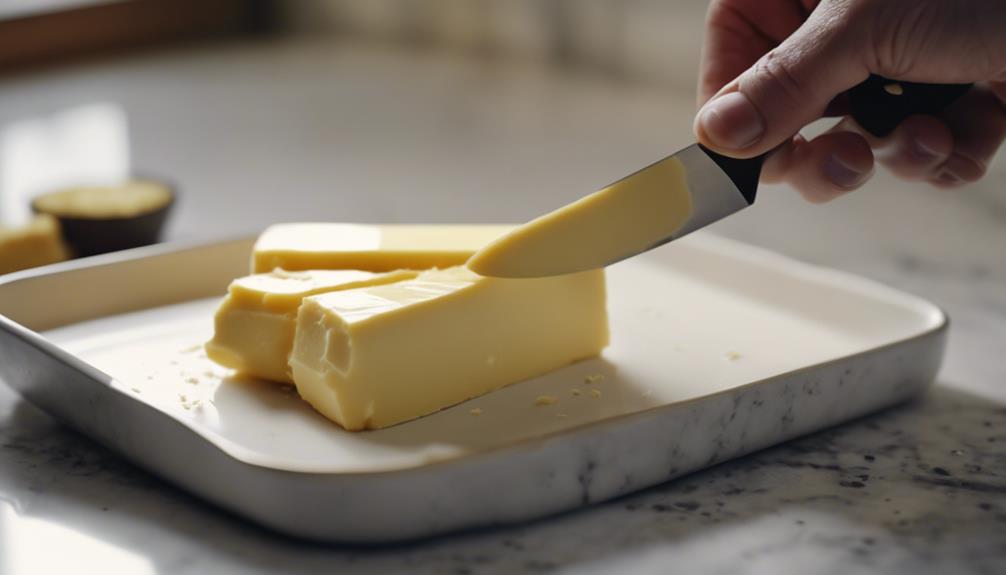
When it comes to measuring butter for recipes, you need to pay attention to accuracy. Understanding the equivalents and conversions of butter sticks is essential for successful baking.
Converting butter measurements can help you achieve precise results in your culinary creations.
Butter for Baking
When baking, ensure accuracy by measuring butter following the markings on the stick or using the displacement method for partial stick measurements.
One-third cup of butter translates to 5 tablespoons + 1 teaspoon, simplifying the process for baking recipes.
Butter sticks conveniently come marked with measurements for tablespoons and cups, making it easier to measure accurately.
Understanding the significance of butter measurement in recipes is essential for achieving the desired texture and flavor in your baked goods.
Ensuring you measure 1/3 cup of butter accurately not only guarantees consistency in your baking results but also helps maintain the intended balance of ingredients.
For precise measurements when dealing with partial sticks, consider using the displacement method with cold water to measure the exact amount of butter needed for your recipe.
Butter Measurement Accuracy
Accurately measuring butter for recipes is key to achieving consistent and delicious results in your cooking and baking endeavors. When it comes to measuring butter, precision is vital for ensuring your dishes turn out just right.
Here are some tips to help you measure butter accurately:
- Know Your Sticks of Butter: Understanding that a stick of butter is equal to 1/2 cup or 8 tablespoons can guide you in measuring the right amount for your recipes.
- Measure Butter Correctly: For 1/3 cup of butter, you'll need 5 tablespoons plus 1 teaspoon. Paying attention to these small details can make a big difference in your final dish.
- Utilize Pre-Marked Wrappers: Using the measurements marked on butter wrappers can simplify the process and save you time when measuring out specific amounts.
- Ensure Recipe Precision: Consistent and accurate butter measurements are essential for achieving the desired texture, flavor, and consistency in your cooking and baking endeavors. By mastering the art of measuring butter, you set yourself up for recipe success.
Converting Butter Measurements
To maintain precision in your recipe preparation, mastering the conversion of butter measurements is crucial. Understanding how to convert butter measurements is vital to adding the correct amount of butter to your recipes, whether you're baking a cake or cooking a delicious meal.
For instance, 1/3 cup of butter is equal to 5 tablespoons plus 1 teaspoon. Knowing this conversion can assist you in accurately measuring butter for your dishes.
When a recipe requires a specific amount of butter, such as 1/3 cup, but you only have sticks of butter available, correctly converting the measurements is crucial. Since a standard stick of butter contains 8 tablespoons or 1/2 cup, you may need to measure out a portion of the stick to obtain the exact amount needed.
Using a kitchen scale or pre-marked butter wrappers can help in measuring 1/3 cup of butter precisely. By mastering the skill of converting butter measurements, you can guarantee that your recipes turn out perfectly every time.
Butter Measurement Tips and Tricks
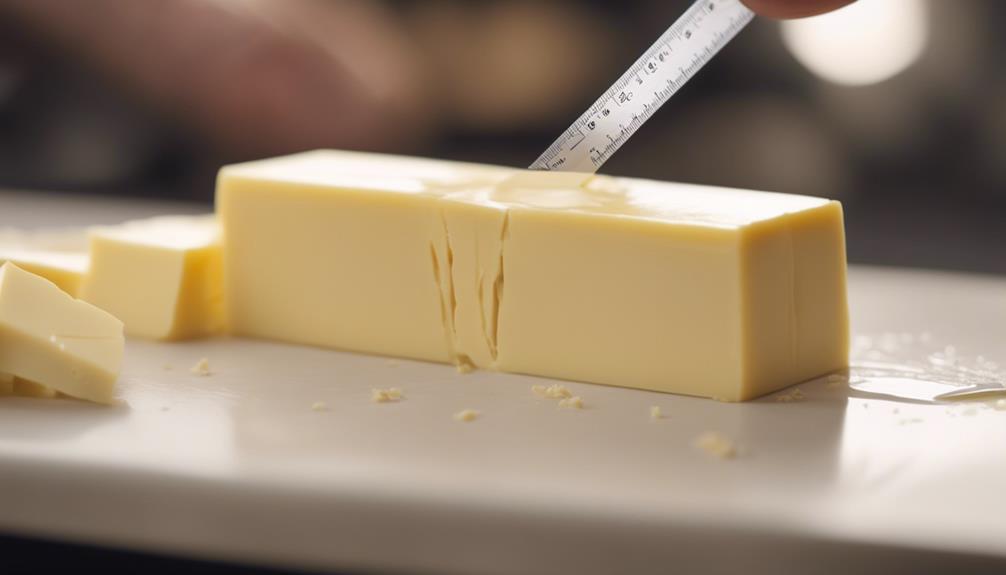
For precise butter measurements in your recipes, consider utilizing the markings on butter wrappers for easy measuring.
Here are some helpful tips and tricks to guarantee accurate butter measurements:
- Stick Equivalents: Remember that a standard stick of butter is equal to 1/2 cup or 8 tablespoons. This information can come in handy when recipes call for specific amounts of butter.
- Measuring 1/3 Cup: To measure 1/3 cup of butter, you'd typically need around 5 tablespoons plus 1 teaspoon. Knowing this conversion can save you time and hassle in the kitchen.
- Butter Wrapper Markings: Take advantage of the markings on butter wrappers, which often indicate measurements by tablespoons, 1/4 cup, and 1/3 cup. These markings can help you measure the right amount of butter effortlessly.
- Displacement Method: If you need to measure an exact amount of butter, consider using the displacement method with water. This technique guarantees precise measurements for your recipes.
Butter Packaging and Measurements
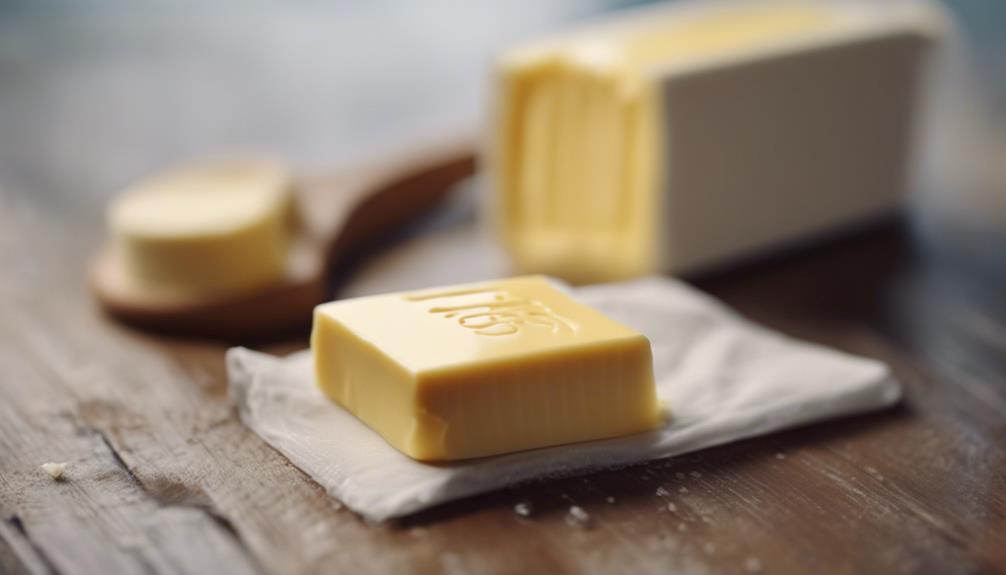
When grabbing a stick of butter, examine the packaging for convenient measurements marked in tablespoons and cups.
These pre-marked wrappers can simplify the process of measuring out precise amounts for your recipes.
Understanding the markings on butter packaging guarantees you get the right measurements every time.
Butter Packaging Efficiency
Butter packaging efficiency enhances the practicality and precision of measuring butter for recipes. Butter sticks are designed to make measuring and using butter more convenient for cooking and baking.
Here are some key points regarding butter packaging efficiency:
- Butter sticks are typically marked with measurements for tablespoons and cups, aiding in accurate measuring.
- Packaging butter in sticks allows for easy storage, stacking, and shipping in stores, reducing waste and maximizing space.
- The markings on butter sticks provide guidance for common measurements like 1/4 cup and 1/3 cup, simplifying recipe preparation.
- Butter sticks are favored in baking and cooking applications due to their practicality and ease of use.
Accurate Butter Measurements
Enhancing recipe precision and convenience, butter packaging with pre-marked measurements simplifies accurate portioning for cooking and baking. Quarter-pound butter sticks typically contain 8 tablespoons, allowing for easy measurement of 1/3 cup. The shape of butter sticks aids in precise measuring, especially in 1/3 cup increments. By understanding butter packaging measurements, you guarantee accurate ingredient amounts in your recipes.
To give you a clearer picture, here is a breakdown of how much butter is needed to make 1/3 cup:
| Butter Quantity | Equivalent to 1/3 Cup |
|---|---|
| One stick | 1/3 cup |
| Two sticks | 2/3 cup |
| Three sticks | 1 cup |
| Four sticks | 1 1/3 cups |
Challenges With Measuring Melted Butter
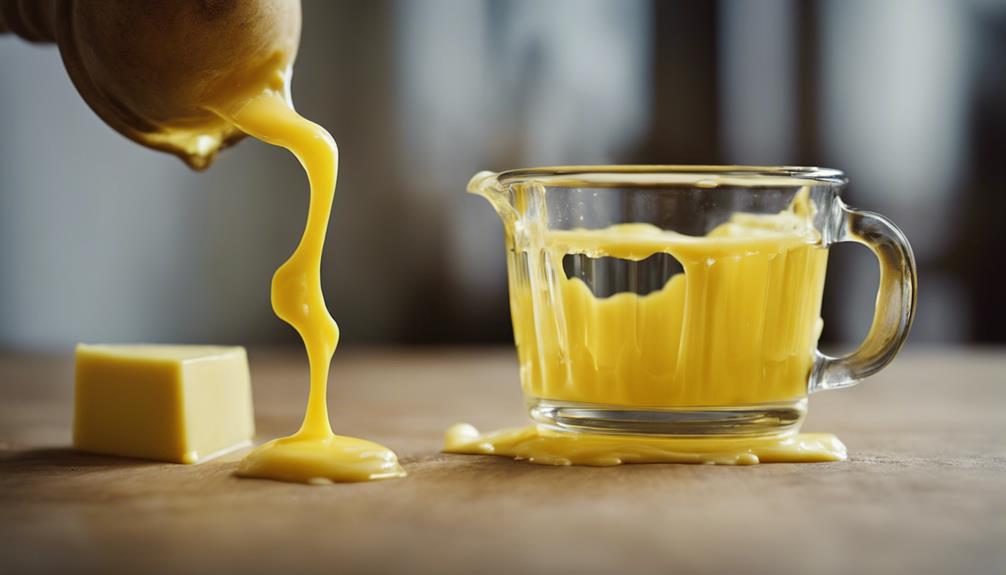
Measuring melted butter can present difficulties due to the varying interpretations in recipes. When dealing with melted butter, the process of measurement can be challenging, leading to potential inaccuracies in your cooking. Here are some common challenges you might encounter:
- Ambiguity in Measurement Instructions: Recipes often fail to specify whether the measurement of butter should be taken before or after melting, causing confusion.
- Specific Measurement Requirements: Some recipes demand precise amounts of melted butter, making it essential to measure accurately for the dish's success.
- Understanding Equivalences: Knowing how melted butter measures up to solid butter is important for converting measurements accurately.
- Texture and Consistency: Accurate measurements of melted butter are essential in achieving the desired texture and consistency in your final dish.
To avoid errors, double-check the recipe's instructions and clarify any uncertainties regarding the measurement of melted butter. This attention to detail can make a significant difference in the outcome of your culinary creations.
Standardizing Butter Measurements
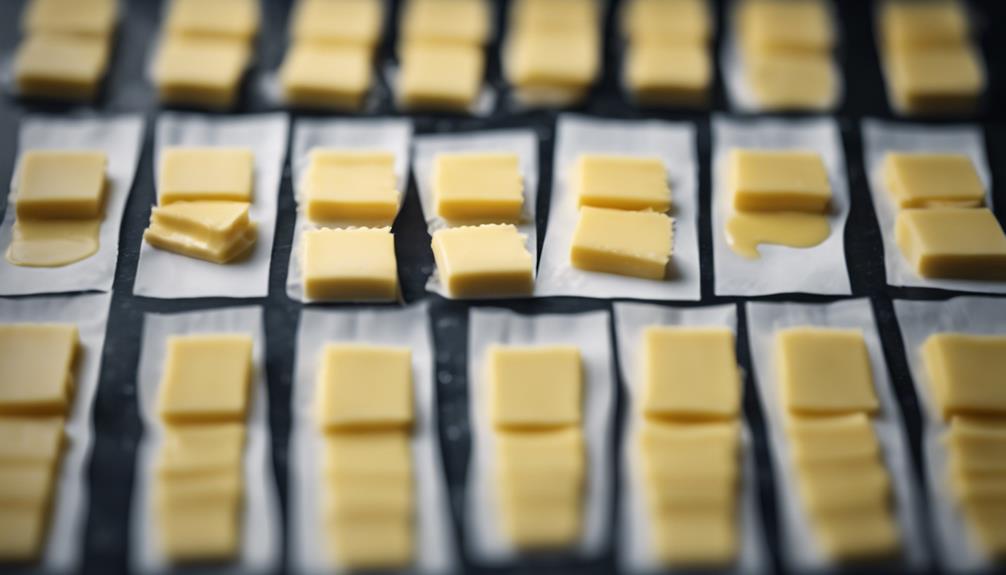
To maintain accurate and consistent results in your recipes, consider standardizing your butter measurements by weight. When a recipe calls for a specific amount of butter, measuring it accurately is crucial to guarantee your baked goods turn out as intended.
Instead of relying on the volume measurement of a cup of butter, which can vary due to factors like softness and air pockets, using a kitchen scale to weigh your butter provides a more precise measurement. Soft butter can easily compress or trap air, leading to inaccurate volume measurements.
By standardizing butter measurements, you eliminate the guesswork and potential for error, resulting in improved baking outcomes. Creating a cheat sheet with the weight equivalents of common butter measurements can serve as a useful reference guide in the kitchen.
Consistent measurement of butter not only simplifies the baking process but also helps you achieve dependable and delicious results every time.
Displacement Method for Butter

Consider utilizing the displacement method for butter when you require precise measurements for your recipes. This technique involves filling a liquid measuring cup with water and adding cold butter until the water reaches the desired amount. By draining the water and using the butter that displaced it, you can accurately measure the required quantity of butter, particularly when a recipe calls for 1/3 cup of butter.
Here are some key points to keep in mind:
- The displacement method guarantees accurate measurements without relying solely on pre-marked packaging measurements.
- It's especially useful for measuring melted butter or irregularly shaped pieces of butter for recipes.
- To convert the volume measurement to weight, remember that 1/3 cup of butter is approximately 76 grams.
- This method can be applied to any specific stick of butter, allowing for flexibility in measurements based on recipe requirements.
International Baking and Butter Measurements
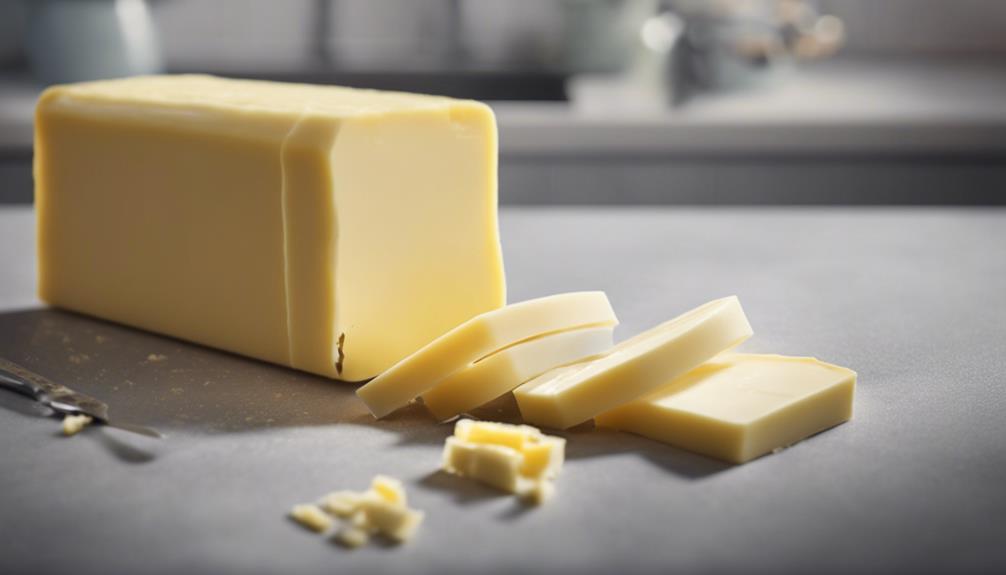
International bakers may face challenges when it comes to working with varying systems of measurement for butter, particularly in recipes that require precise conversions. When dealing with American recipes that often specify butter in cups or sticks, understanding the equivalent measurements in your local system is essential. Here's a handy reference table to assist you in converting common butter measurements:
| Butter Measurement | Cups | Sticks | Grams/Ounces |
|---|---|---|---|
| 1/4 cup | 1/2 | 1/2 | 57g/2oz |
| 1/2 cup | 1 | 1 | 113g/4oz |
| 1 cup | 2 | 2 | 227g/8oz |
| 1 stick | 1/2 | 1/4 | 113g/4oz |
| 1 pound | 2 | 4 | 454g/16oz |
Frequently Asked Questions
How Many Sticks Is 12 Cups of Butter?
To find out how many sticks 12 cups of butter is, imagine each stick as 1/2 cup. So, with 12 cups, you'd have 24 sticks of butter. That's a lot of butter for some serious baking!
What Is One Stick of Butter Equal to in Cups?
One stick of butter equals 1/2 cup or 8 tablespoons. It's a reliable measure for your recipes. Guarantee precision in your cooking and baking by knowing this equivalent. Butter sticks make measuring easy, so you'll never miss a beat.
How Many Sticks of Butter Is 1 Cup Melted?
To measure 1 cup of melted butter, you need 2 sticks. Knowing this conversion is essential for accurate baking. Melted butter is versatile in recipes like sauces or cookies, making it a must-have in your kitchen.
How to Measure Butter in Cups?
To measure butter in cups, fill a measuring cup with the required amount. Use 1/2 cup or 8 tablespoons for a stick of butter. Remember, 1/3 cup equals 5 tablespoons plus 1 teaspoon. Follow these steps for precise measurements.
Conclusion
To sum up, knowing how to measure butter accurately is crucial for successful baking and cooking. Whether you're using a stick of butter, tablespoons, or cups, understanding the conversions and techniques can make a significant impact on your results.
So next time you're reaching for that stick of butter, keep these tips and tricks in mind to guarantee your recipes turn out perfectly every time.
Happy baking!
